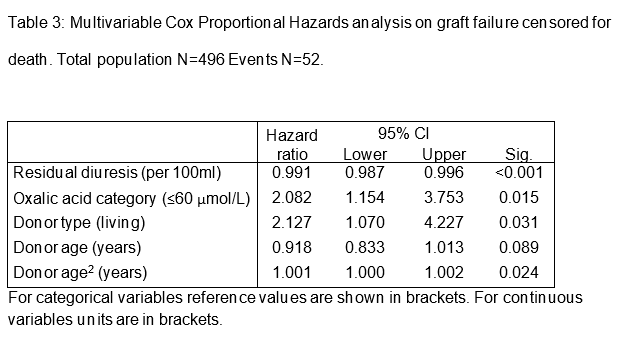Pre-transplant residual diuresis and oxalic acid concentration significantly and independently influence kidney graft survival
Gideon Post Hospers1, Mirjam Laging1, Wesley J. Visser2, pedro Miranda Afonso3, Jeroen G.H.P. GHP Verhoeven1, Ingrid RAM Mertens zur Borg4, Dennis A Hesselink1, Anneke ME de Mik-van Egmond2, Michiel GH Betjes1, Madelon van Agteren1, David Severs1, Jacqueline van de Wetering1, Robert Zietse1, Michel J Vos5, Ido P Kema5, Marcia ML Kho1, Marlies EJ Reinders1, Joke I Roodnat1.
1Erasmus MC Transplant Institute, internal medicine, nephrology, erasmus MC, Rotterdam, Netherlands; 2Department of Internal Medicine, Division of Dietetics, erasmus MC, , Rotterdam, Netherlands; 3Department of Epidemiology and Biostatistics, erasmus MC, Rotterdam, Netherlands; 4Department of Anesthesiology, erasmus MC, Rotterdam, Netherlands; 5Department of Clinical Chemistry Metabolic diseases, University medical center Groningen, Groningen, Netherlands
Introduction: Oxalic acid, a toxic waste product that accumulates as kidney function deteriorates, precipitates at plasma concentrations above 30-40 µmol/L. We studied the influence of oxalic acid and its precursors along with residual diuresis on kidney transplant outcomes.
Methods: Patients who received a kidney transplant between September 2018 and January 2022 participated in the study. Concentrations of oxalic acid, and precursors were determined in pre-transplant blood samples. Data on residual diuresis and other recipient, donor or transplant related variables were collected. Follow-up lasted until July 1st 2023.
Results: 496 patients were included, 154 were not on dialysis yet. Oxalic acid concentrations exceeded the upper normal concentration in 98.8% of patients. There were 52 (10%) graft failures. The influence of oxalic acid on graft failure censored for death was non-linear: it was categorized into two groups: ≤60 and >60 μmol/L. In multivariable Cox analysis the graft failure censored for death risk was significantly influenced by residual diuresis, donor type, donor age and oxalic acid.

Conclusion: Residual diuresis and oxalic acid concentration are important and independent predictors of graft failure censored for death. Intensified dialysis or extra dialysis before transplantation and/or pre-emptive transplantation may positively impact kidney transplant outcomes.
[1] delayed graft function
[2] graft failure
[3] kidney transplantation
[4] oxalic acid
[5] patient survival
[6] residual diuresis
